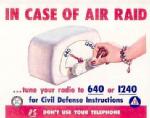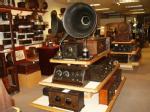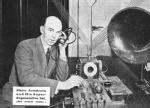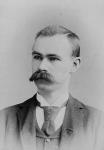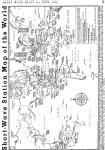
List of manufacturers United States of America (USA)
List of radio manufacturers: the radio manufacturers of German-speaking countries and a beginning for other countries. Please inform us of other radio manufacturers.
| Manufacturers by alphabet | Model count | Models with | Total | ||||||||||
|---|---|---|---|---|---|---|---|---|---|---|---|---|---|
| Total | <1930 | >1942 | |||||||||||
| 1 | 0 | 1 | 1 | 1 | 11 | 1 | ||||||||
| 1 | 0 | 1 | 1 | 1 | 2 | 2 | ||||||||
| 3 | 0 | 3 | 3 | 7 | 1 | |||||||||
| 1 | 0 | 1 | 1 | 6 | 1 | |||||||||
| 1 | 0 | 1 | 1 | 2 | 1 | |||||||||
| 11 | 0 | 11 | 11 | 11 | 11 | 10 | 50 | 22 | 1 | |||||
| 1 | 0 | 1 | 1 | 1 | 1 | |||||||||
| 2 | 0 | 2 | 2 | 2 | 1 | |||||||||
| 5 | 0 | 5 | 5 | 5 | 19 | 2 | ||||||||
| 1 | 0 | 1 | 1 | |||||||||||
| 2 | 0 | 2 | 2 | 8 | 1 | |||||||||
| 1 | 0 | 1 | 1 | 1 | 9 | 3 | ||||||||
| 47 | 0 | 47 | 27 | 33 | 21 | 42 | 162 | 39 | 2 | |||||
| 12 | 0 | 12 | 12 | 3 | 82 | 1 | ||||||||
| 14 | 0 | 14 | 14 | 9 | 9 | 4 | 1 | 117 | 33 | 1 | ||||
| 1 | 0 | 1 | 1 | 1 | 1 | |||||||||
| 1 | 0 | 1 | 1 | 8 | 1 | |||||||||
| 21 | 0 | 21 | 20 | 5 | 4 | 13 | 125 | 5 | 1 | |||||
| 25 | 0 | 23 | 1 | 14 | 6 | 1 | 10 | 37 | 9 | 4 | ||||
| 1 | 0 | 1 | 1 | 1 | 1 | |||||||||
| 3 | 0 | 1 | 3 | 1 | 4 | |||||||||
| 2 | 0 | 2 | 2 | 4 | 1 | |||||||||
| 2 | 0 | 2 | 2 | 11 | 1 | |||||||||
| 1 | 0 | 1 | 1 | 1 | 10 | 2 | ||||||||
| 1 | 0 | 1 | 1 | 1 | 1 | 1 | 1 | 11 | 1 | 1 | ||||
| 5 | 0 | 5 | 1 | 4 | 1 | 1 | ||||||||
| 1 | 0 | 1 | 1 | 1 | 2 | 1 | ||||||||
| 27 | 0 | 27 | 27 | 6 | 6 | 14 | 125 | 20 | 2 | |||||
| 1 | 0 | 1 | 1 | 1 | ||||||||||
| 7 | 0 | 7 | 6 | 6 | 5 | 6 | 58 | 17 | 1 | |||||
| 1 | 2 | 1 | 1 | 1 | 1 | |||||||||
| 64 | 0 | 63 | 1 | 56 | 3 | 3 | 31 | 366 | 4 | 2 | ||||
| 1 | 0 | 1 | 1 | 1 | 1 | 1 | 2 | 6 | 1 | |||||
| 1 | 0 | 1 | 1 | 1 | 2 | 1 | ||||||||
| 1 | 0 | 1 | 1 | 1 | 2 | 3 | ||||||||
| 17 | 0 | 16 | 14 | 1 | 1 | 10 | 56 | 1 | 2 | |||||
| 3229 | 2 | 5 | 2850 | 1333 | 2599 | 968 | 2605 | 377 | 4192 | 29933 | 3 | |||
| 8 | 0 | 8 | 1 | 3 | 1 | 1 | ||||||||
| 5 | 0 | 5 | 5 | 1 | 22 | 2 | ||||||||
| 1 | 2 | 1 | 1 | 1 | 1 | 1 | 1 | 1 | 1 | |||||
| 26 | 0 | 18 | 14 | 4 | 2 | 24 | 32 | 4 | 1 | |||||
| 1 | 0 | 1 | 1 | 1 | 1 | |||||||||
| 7 | 0 | 7 | 1 | 7 | 1 | 2 | ||||||||
| 3 | 0 | 3 | 3 | 2 | 1 | 14 | 1 | |||||||
| 14 | 0 | 14 | 12 | 9 | 7 | 10 | 37 | 34 | 2 | |||||
| 1 | 0 | 1 | 1 | 1 | 7 | 2 | ||||||||
| 8 | 0 | 8 | 7 | 8 | 31 | 1 | ||||||||
| 18 | 0 | 18 | 11 | 3 | 3 | 8 | 17 | 57 | 5 | 1 | ||||
| 2 | 0 | 2 | 2 | 2 | 7 | 3 | ||||||||
| 3 | 0 | 3 | 3 | 11 | 2 | |||||||||
| 3 | 0 | 3 | 2 | 2 | 16 | 1 | ||||||||
| 6 | 0 | 6 | 6 | 3 | 13 | 1 | ||||||||
| 4 | 0 | 4 | 2 | 1 | 5 | 1 | ||||||||
| 1 | 0 | 1 | 1 | 8 | 1 | |||||||||
| 1 | 0 | 1 | 1 | |||||||||||
| 2 | 0 | 2 | 2 | 2 | 2 | 2 | 20 | 2 | ||||||
| 21 | 0 | 17 | 21 | 4 | 4 | 13 | 67 | 7 | 2 | |||||
| 5 | 0 | 5 | 5 | 14 | 1 | |||||||||
| 1 | 1 | 1 | 1 | 1 | 18 | 1 | ||||||||
| 4 | 0 | 4 | 1 | 1 | 3 | 1 | 1 | 1 | ||||||
| 1 | 0 | 1 | 1 | 1 | 1 | |||||||||
| 3 | 0 | 3 | 2 | 3 | 2 | 3 | 3 | 9 | 2 | |||||
| 7 | 0 | 7 | 7 | 5 | 14 | 1 | ||||||||
| 2 | 0 | 2 | 2 | 2 | 4 | 1 | ||||||||
| 8 | 0 | 3 | 2 | 6 | 3 | 3 | 4 | 22 | 13 | 2 | ||||
| 1 | 0 | 1 | 1 | 13 | 1 | |||||||||
| 35 | 0 | 35 | 34 | 35 | 176 | 2 | ||||||||
| 64 | 0 | 64 | 29 | 60 | 27 | 62 | 44 | 704 | 1 | |||||
| 5 | 0 | 5 | 5 | 1 | 4 | 21 | 2 | |||||||
| 1 | 0 | 1 | 1 | 9 | 1 | |||||||||
| 5 | 0 | 5 | 5 | 5 | 5 | 5 | 5 | 12 | 1 | |||||
| 39 | 0 | 39 | 37 | 15 | 13 | 23 | 16 | 101 | 178 | 1 | ||||
| 4 | 0 | 4 | 3 | 2 | 15 | 1 | ||||||||
| 1 | 0 | 1 | 1 | 8 | 1 | |||||||||
| 293 | 0 | 1 | 87 | 147 | 240 | 97 | 284 | 539 | 764 | 2 | ||||
| 2 | 0 | 2 | 2 | 2 | 2 | 2 | 2 | 8 | 1 | |||||
| 9 | 0 | 9 | 8 | 9 | 8 | 9 | 12 | 35 | 2 | |||||
| 4 | 0 | 4 | 4 | 29 | 2 | |||||||||
| 5 | 0 | 5 | 4 | 2 | 2 | 17 | 1 | |||||||
| 4 | 0 | 4 | 4 | 4 | 1 | |||||||||
| 1 | 0 | 1 | 1 | 2 | 1 | |||||||||
| 8 | 0 | 8 | 2 | 15 | 1 | |||||||||
| 1 | 40 | 1 | 1 | 1 | 3 | 2 | ||||||||
| 4 | 0 | 4 | 3 | 2 | ||||||||||
| 8 | 0 | 8 | 6 | 7 | 26 | 1 | ||||||||
| 1 | 0 | 1 | 1 | 1 | 1 | 2 | ||||||||
| 1 | 0 | 1 | 1 | 1 | 5 | 1 | ||||||||
| 24 | 0 | 24 | 14 | 2 | 2 | 23 | 141 | 2 | 2 | |||||
| 3 | 0 | 3 | 3 | 3 | 6 | 1 | ||||||||
| 23 | 0 | 23 | 23 | 22 | 127 | 1 | ||||||||
| 6 | 0 | 6 | 2 | 13 | 2 | |||||||||
| 1 | 0 | 1 | 1 | 1 | 2 | |||||||||
| 8 | 0 | 8 | 4 | 4 | 21 | 1 | ||||||||
| 6 | 0 | 6 | 3 | 6 | 3 | 5 | 11 | 12 | 2 | |||||
| 1 | 0 | 1 | 1 | 7 | 1 | |||||||||
| 1 | 0 | 1 | 1 | 1 | 1 | |||||||||
| 1 | 0 | 1 | 1 | 3 | 1 | |||||||||
| 30 | 0 | 30 | 26 | 1 | 1 | 2 | 28 | 114 | 1 | 1 | ||||
| 2 | 0 | 2 | 2 | 2 | 3 | 1 | ||||||||
| 5 | 0 | 1 | ||||||||||||
Under the term radio manufacturer, we also include producers, for example, of parts of radios, "radio-related equipment", etc. produced for companies or commercial radio. Manufacturers of old radios are as covered as completely as possible for the German-speaking countries, but only partially for other countries. There are thousands of radio manufacturers.
Text/Pictures for United States of America (USA)
Excerpt from the book "Radios von gestern" (by Ernst Erb), published in 1989.
A liberal open-market environment that merely ensures that a mix-up of wavebands is prevented facilitates the awarding of licenses for the broadcasting and/or receiving of radio frequencies. Also contributing to the early and rapid development of radio broadcasting in the U.S. are the Audion (triode) by Dr. Lee de Forest, as well as a period of peacetime in the home country.In 1899 Marconi establishes in New Jersey the American Marcony Wireless Telegraph Company. The first exchange of signals takes place in 1901 from the station in Siasconset on Nantucket island. It's over a distance of 40 miles [151]. The same year Marconi experiments with oversea transmissions. De Forest founds in 1901 the Wireless Telegraph Company of America. Abraham Schwartz (later on White!) establishes together with de Forest another company in which Schwartz concentrates on raising "venture capital". This company, called American de Forest Wireless Tel. Company, is capitalized with 10 million Dollars. With its 27 land stations it is by 1906 the biggest broadcasting company in the U.S. Infringements of patents held by Fessenden on electrolytic detectors force a switch to silicone detectors for which General H. H. Dunwoody had obtained patents in 1906. In November de Forest leaves the company. At that time White restructures it into the United Wireless Telegraph Company. The "American" is absorbed in 1907. In the "United", C.C. Wilson assumes the presidency. The company goes 1911 into receivership and as a result of a lost patent case Marconi acquires it in 1912. Now, the Marconi company takes possession of 70 land and 500 offshore (boat mounted) stations and thus becomes the only broadcasting enterprise of any importance in the United States. At the request of the government GE acquires in 1919 from the English owners a majority interest in American Marconi. A few months later, that share package is used to form together with Western Electric, joined at a later stage by Westinghouse, the Radio Corporation of America (RCA). The de Forest company is during the first decades of the 1900s the only serious competitor in the market for amateur and commercial stations. Production stops in 1925.
The U.S. navy returns in March of 1920 all broadcasting stations to the original owners. Immediately, RCA installs several high-frequency alternators (New Brunswick NJ, Chatham Mass., Bolinas CA, Kahuku on Hawaii) which outperform the 500-kW-arc transmitter. These arc transmitters are already six times more powerful than the spark transmitters. Transmitters based on tube technology are at this stage suitable only for smaller applications.
Broadcast Stations
In 1919 Dr. Frank Conrad, an employee of Westinghouse, sends out signals in Pittsburgh, PA, which can be received in a shopping center in the same city. It is a promotion for detector radios that can be bought there for 10 Dollars. For [151] thus begins the worldwide radio broadcasting (see Belgium 1913!). According to other documents it is the Marconi station XWA in Canada that commences radio broadcasting in 1919 as well. Westinghouse takes over Dr. Conrad's KDKA station in 1920 and commercializes the idea. The station gains some popularity during the presidential election (Warren G. Harding). The opening concert takes place on November 2, 1920.The Pittsburgh radio station, its power increased in the summer of 1921, broadcasts now concerts on a regular basis. Though everyone may operate a radio receiver, the interest remains negligible. Despite of this, Westinghouse sets up a small station in Newark NJ to broadcast as a test the boxing match between Carpentier - Dempsey. The response is such that only two weeks later a radio station opens up in New York City. It offers daily news reports, concert presentations, as well as a special evening program for children and general night programming. It triggers such a run on radio receivers that it requires a special relationship with a radio manufacturer to be reasonably sure that there will be a radio under the Christmas tree in 1921 [159].
1922 sees a rapid rise in demand. In the U.S. sixty radio stations operate on March 1, 1922, In November of the same year the number has risen to 564! These numbers are from "Radio Today", Geneva Research Centre Geneva (Article "The Present State of Broadcasting in the World". It appeared in summer of 1942, research supported by the Rockefeller Foundation). Statistics for the U.S. from 01.01,1923 provide these figures: 569 major stations (likely all of them commercial radio stations), 16,898 amateur stations (at that time apparently permitted to transmit "radio-like" broadcasts), 167 municipal stations for trade purposes, 12 overseas stations, 126 transmitters at technical colleges, 291 test and 201 special stations for direction finding devices, etc., 39 coastal stations and 2,762 offshore (on board) stations.
Radio stations WEAE of New York and WNAC of Boston agree on April 1, 1923 on a broadcasting partnership [149]. The same year advertising becomes officially permitted [155]. In 1924 an estimated 3 million private receivers, 30,000 amateur and 5,000 commercial broadcasting stations exist. Of that, by November 1924 a total of 1,105 stations are traced back to manufacturers, distributors, news agencies, hotels, railway companies, church communities and other organizations. The stations are all transmitting on wave bands of between 231m and 545m; they operate on average at approximately one kW output. Policemen in Chicago employ portable receivers whose antenna is sewn into their uniform in a zigzag pattern. The Department of the Interior works on a plan that is meant to bring schooling via radio on a regular basis to over 2 million children living in very remote regions of the country. The major station Virginia transmits twice a week educational material. Though radio listeners pay no fees, radio stations are almost exclusively owned by private interests. The government merely awards the license and directs waveband and broadcasting times. Stations up to 500 Watt (A-License) are allocated frequencies within the 231 - 300m range. Class B stations, those with higher power, are in the 300 - 545m band. Some frequencies within this range are claimed by the coast guard (286 - 288, 300 and 450m) Amateurs are allowed to transmit on 150 - 200m and amateurs who use their installation for educational purposes have 200 - 222m assigned to them. Wavebands 222 - 231 are reserved for the government regulated air traffic. Wavebands under or above the listed bands are put aside for sea and air traffic stations (545 - 1277), scientific purpose (1277 - 1304m) or so far undefined government use.
On September 14, 1926, RCA establishes a subsidiary, namely National Broadcasting Corporation [149]. NBC maintains two networks of stations, the "red network" and the "blue network" with a total of 244 outlets [155]. In 1927 the Columbia Broadcasting System (CBS) comes into being. A community of common interests is formed in 1934 when several stations get together to form the network Mutual Broadcasting System (MBS). By 1936 MBS is in serious competition with the two national networks. Two thirds of all stations belong to these three networks. Meanwhile, Crosley Corporation, Associated Broadcasters Inc., General Electric Company, Westinghouse Electric & Manufacturing Company and the non-commercial World Wide Broadcasting Foundation of Boston operate on short-wave. In 1934 the Federal Communications Commission (FCC), an agency of the federal government in Washington, assumes control of frequencies and signal strength. FCC also functions in a supervisory role over the general administration of broadcasting companies. Basically, any qualified person is still permitted to set up a station. Broadcasts with political content require that authorized representatives of all parties enjoy equal rights.
FM stations
The work of Major Armstrong in the early '30s dealing with frequency modulation reaches its peak with the November 1935 publication of "A Method of Reducing Disturbances in Radio-Signalling by a System of Frequency Modulation" (Institute of Radio Engineers, NY). Following some experimental broadcasts the FCC releases in May of 1940 thirty-five channels in the frequency band 42 to 50 MHz (6-7, 15m). Each station has at its disposal 200 kHz of which 75 kHz are to be used for audio broadcasting. The remaining bandwidth may be used for video broadcasting. According to White's Radio Log of April 1944, there are since the beginning of 1944 already 51 commercial FM stations in existence. The number of sold FM receivers reaches allegedly one million. Some networks are connected from 1941 onwards through radio links. Armstrong puts in 1941 his 17 FM-patents free of charge at the disposal of his government for use in the defence of the country.Magazines
In the 1910's Gernsback, Doubleday and Scientific American [151] figure prominently in the first publications on the subject of "wireless transmission". Other periodicals such as Modern Electrics and The Electrical Experimenter favor similar content. The publications of the radio amateur organization American Radio Relay League play a special role in spreading the word about the new medium.By 1924 there are over a dozen major journals on the subject. The two best known ones, both monthlies published in New York, are likely the Wireless Age and Radio News. Soon the number of publications having radio as the theme literally explodes. Among the better known ones are Radio Daily publishing on a daily basis; Broadcasting & Broadcast Advertising, as well as Variety are weeklies. Radio-Craft appears once a month; the quarterlies include Air Law Review, RCA Review, Talks and The Public Opinion Quarterly [155]. It should further be noted that some time after WW2 numerous collector clubs were formed. Members have the choice to declare any such membership to have it appear in their respective profile.
Radio Industry
A defined radio industry develops very early. In its initial stages production could hardly keep pace with demand. According to [152] Mignon introduces in 1914 with the RLC2 a detector radio for the general public. Other models by this manufacturer are not known. Quite in contrast is the "de Forest" company which in [152] appears only in 1919. However, by 1930 de Forest has 40 models on the market. The company's products from 1907 onwards are initially not classified as "broadcast receivers". The Adams-Morgan Co. builds in 1916 a radio device, follows up in 1921 with additional models but ceases production in 1925 after having come out with a total of 17 different models. Other companies pursuing this new line of business include Kennedy Co. (until 1930 74 models), Radio Apparatus (3 models), Commerce and Electro Importing limit themselves to offering only one model respectively.How did the development and production of radio equipment really get started in the U.S.?
Prior to the time when broadcasting as a movement took off, there were only a few commercial stations and the steadily growing number of amateurs who needed a receiver. (See the chapter on amateur radio enthusiasts in "Radios von gestern"). In 1920 Armstrong searches for license-takers for his regeneration (reaction) patent as annual fees and lawyer costs become a heavy burden. Up to that time amateurs more or less built their receiving devices themselves and thus avoided paying a license fee. In an advertisement Armstrong offers to the growing number of commercial manufacturers the legal use of his patent for a fee of 5% of the selling price. In approximately this sequence the following companies accept the offer:
American Marconi (for 2 stations only), International Radio Telegraph Co., Inc; A.H. Grebe & Co., Chicago Radio Laboratory (Zenith from 15.02.1920); Clapp-Eastham Co. (on 18.04.1920); Cutting & Washington Inc. (on 07.07.1920, company later renamed Colonial); Adams-Morgan Co.; The Precision Equipment Co. (later on taken over by Crosley); Jones Radio Co. (Kellogg affiliation); Mignon Mfg. Export Corp.; Tri-City Electric Mfg. Co. (became supplier to Montgomery Ward); Klitzen Radio Mfg. Co. (Michigan affiliation); The Radio Shop (later on Echophone); Oard Radio Laboratories; Pennsylvania Wireless Mfg. Co.; The C.D. Tuska Co.; Radio Craft Co., Inc. (on 20.09.1920, later bought out by de Forest); The Colin B. Kennedy Co.; Eastern Radio Co.; Chelsea Radio Co. Still in 1920, Armstrong manages to sell his rights on the regeneration (reaction or positive feedback) and the superheterodyne patents to Westinghouse which brings those patents into its association with RCA. Now, no additional companies can obtain a license on these patents. A monopoly on the production of good receivers is, however, at that time no longer within reach of RCA - thanks to all those mainly young radio amateurs who run basement operations with small production runs. With the exception of the two first named firms, all of the above companies fall into this category. Their products are sold through advertisements. Some of these small entrepreneurs ride the radio boom of 1921 and grow into big corporations or are at least successful for a few years until TRF (radios with Tuned Radio Frequency) and superhets in 1923/24 spell the end of the regenerative TRF. Zenith, Colonial, Grebe, Kennedy and Crosley belong into this group. A few manufacturers of low-priced sets, e.g. Crosley, stay with the regenerative system a while longer. Selectivity is in these early stages in the U.S. no issue as all stations broadcast on 360m and switch for weather and market reports to 485m. Transmitter power is small, distances between stations substantial, which ensures generally good reception with a regeneration TRF set unless there is a nearby transmitting station.
In the spring of 1922 major stations are allocated the 400m band. One also anticipates an annual growth in radio receivers of one million home made units against only less than 100,000 commercially produced sets. Only as of May 1923 do radio stations transmit in the entire broadcast band. With that, selectivity gains more importance. The answer to that requirement comes via the Neutrodyne or (the more expensive) Superhet. Exceptions are some regenerative receivers with iron core transformer, such as the D10 from de Forest or the 61 from Federal.
The following companies are licenced by Hazeltine to produce Neutrodyne receivers:
American Radio & Research Corp. (later Crosley); F.A.D. Andrea, Inc. (FADA); Carloyd Electric & Radio Corp. (Malone-Lemmon); Eagle Radio Corp.; Freed-Eisemann Radio Corp.; Garod Corp.; Radio Service Laboratories, Inc. (bought out by Gilfillan); Howard Mfg. Co.; Broadcast Mfrs., Inc. (bought out by King Quality Products, Inc.); Wm. J. Murdock Co. (bought by Philco); Stromberg-Carlson Telephone Mfg. Co.; R.E. Thompson Mfg. Co.; Ware Radio Corp.; Workrite Mfg. Co.
During the years 1923-25 the scene is dominated by sets with three big control knobs; Charles Freshman with its low-priced models Freshman-Masterpiece holds a commanding market share. The company sells 125,000 sets in seven successive months from August 1924 on. Atwater Kent circumvents patents through skillful use of wiring capacitance and builds about 100,000 breadboard models plus half a million enclosed sets; i.e. Atwater Kent sells in 1925 more sets than all the other Neutrodyne-TRF radio manufacturers combined. In response to the wishes for simplified control by the ever growing user community Thermiodyne in July and Magnavox in September of 1924 link the variable condensers so that for best reception only the trimmer needs to be attended to. Mohawk introduces in November of 1924 the first trimmer-less one-knob radio. Zenith is first with a station-dial which 1926-28 becomes the standard feature.
Also in 1924, first tests are conducted in the U.S. with radios drawing their power from the main. Dynamotive Radio Corp. brings in July with the Dynergy RC250 the first such radio to market. However, the set still uses battery tubes 01A in series as per the patent by Samuel P. Levenberg, No. 1670893 of 22.05.1928; registered on December 8, 1923. Although the radio sells well, Dynamotive does not survive the year 1925. The Super-X from Zenith in September and the MA20 by Mu-Rad in October are flops. The first practical AC-main-set sold in the U.S. may well be the Radiola 30 marketed by RCA from September 1925. Only the indirectly heated tubes from McCullough, made by Kellogg, open up new possibilities. Efforts by Arcturus and Sparton follow and RCA in 1927 with the 226 and 227 tubes, and the model Radiola 17, sets the new industry standard.
By the end of 1927, U.S. companies have sold a total of 13,250,000 receivers (total revenue 2 billion U.S. $). Demand in 1928 is up from 7.5 million units the previous year by 20% to 9 million units and increases again in 1929 by 31% to 11.8 million units. In spite of these growth rates, the number of manufacturers (600 to 1200, depending on whose statistics one uses) shrinks drastically within only four years to a tenth [287] of the previous number. Many companies simply miss the jump to radios drawing their power from the main; others can not handle the ever more complex circuitry by now required to ensure good reception. Patent issues play a bigger role now as well.
A further six pages from the book exceed the available space here - I may bring them in at a later date as a Forum contribution. This text has been translated by Alfred Zeeb, Canada. Thank you, Alfred for your efforts.
Text in other languages
| Data Compliance | More Information |

